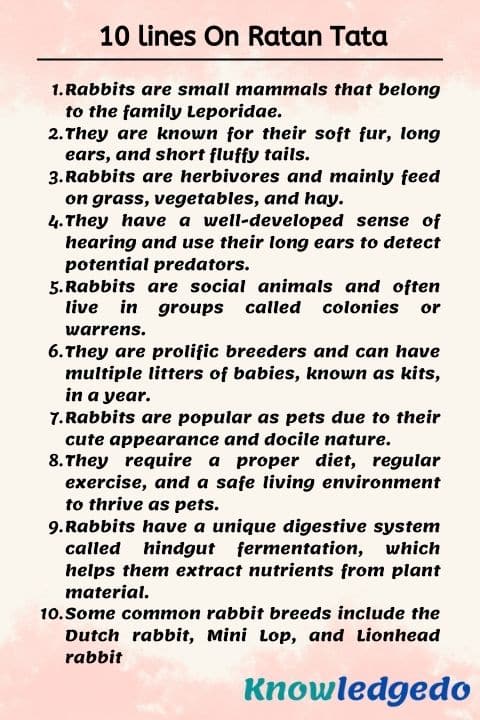Today, we are sharing 10 lines on Ratan Tata in English. This article can help students who are looking for information about 10 lines on Ratan Tata. This Lines is very simple and easy to remember. The level of these Lines is moderate so any student can write on this topic.
This article is generally useful for class 1,class 2,class 3,class 4,class 5,class 6,class 7,class 8,class 9,class 10,class 11,class 12
10 lines on Ratan Tata
1) Rabbits are small mammals that belong to the family Leporidae.
2) They are known for their soft fur, long ears, and short fluffy tails.
3) Rabbits are herbivores and mainly feed on grass, vegetables, and hay.
4) They have a well-developed sense of hearing and use their long ears to detect potential predators.
5) Rabbits are social animals and often live in groups called colonies or warrens.
6) They are prolific breeders and can have multiple litters of babies, known as kits, in a year.
7) Rabbits are popular as pets due to their cute appearance and docile nature.
8) They require a proper diet, regular exercise, and a safe living environment to thrive as pets.
9) Rabbits have a unique digestive system called hindgut fermentation, which helps them extract nutrients from plant material.
10) Some common rabbit breeds include the Dutch rabbit, Mini Lop, and Lionhead rabbit.

5 lines on Ratan Tata
1) Rabbits are small mammals known for their fluffy fur, long ears, and hopping locomotion.
2) They are herbivores and primarily eat grass, vegetables, and hay.
3) Rabbits are social animals that can live in groups and communicate through body language and vocalizations.
4) They have a keen sense of hearing and can rotate their ears to detect potential dangers.
5) Rabbits are popular as both pets and animals in the wild, and they reproduce quickly with multiple litters per year.
FAQ
Answer: Pet rabbits should primarily be fed a diet of fresh hay, such as timothy or orchard grass, along with a variety of fresh vegetables, such as leafy greens (e.g., kale, romaine lettuce) and small amounts of fruits. Commercial rabbit pellets can also be included in their diet, but they should be given in moderation. It’s important to provide a constant supply of fresh water for your rabbit as well.
Answer: Ensure that your rabbit has a spacious and secure enclosure, such as a rabbit hutch or an indoor pen, with enough room to hop, stretch, and play. Remove any hazardous objects or plants that could harm your rabbit. Provide a comfortable bedding material, such as paper-based or aspen shavings. Regularly clean the enclosure to maintain a hygienic environment. Additionally, rabbits are social animals, so spending time with them and providing mental stimulation through toys and tunnels is essential for their well-being.
Answer: Litter training a rabbit is possible and can make clean-up easier. Start by placing a litter box in a corner of the enclosure where the rabbit tends to eliminate. Fill the litter box with rabbit-safe litter, such as paper-based or aspen shavings. Whenever your rabbit uses the litter box, praise and reward them with treats or gentle petting. If your rabbit eliminates outside the litter box, clean up the mess and place the droppings in the litter box to help them understand where they should go. Consistency, patience, and positive reinforcement are key when litter training a rabbit.
